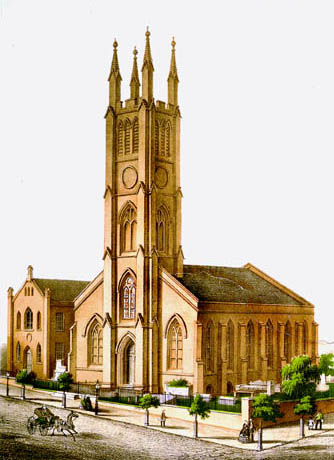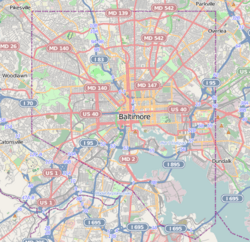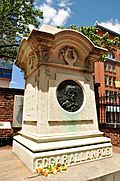Westminster Hall and Burying Ground facts for kids
Quick facts for kids |
|
|
Westminster Presbyterian Church and Cemetery
|
|

Westminster Presbyterian Church, (Baltimore, Maryland) depicted in a postcard, c. 1857
|
|
| Location | 509 West Fayette Street at North Greene Street, Baltimore, Maryland |
|---|---|
| Area | 1 acre (0.40 ha) |
| Built | 1815 |
| Architect | Godefroy, Maximilien; et al. |
| Architectural style | Greek Revival, Exotic Revival, Gothic Revival |
| NRHP reference No. | 74002218 |
| Added to NRHP | September 17, 1974 |
Westminster Hall and Burying Ground is a historic graveyard and a former church building. It is located in Baltimore, Maryland, United States. Today, it is part of the University of Maryland's School of Law. The site is famous as the burial place of the writer Edgar Allan Poe. This important complex was recognized as a national historic district in 1974.
Contents
History of Westminster Hall
The graveyard was started in January 1787. The First Presbyterian Church of Baltimore bought the land for it. They bought it from Col. John Eager Howard, a hero of the American Revolution. Many important people from Baltimore were buried here. These included merchants, politicians, and veterans of the American Revolutionary War and the War of 1812.
In July 1852, the Westminster Presbyterian Church was built. It was built right over the graveyard. Its brick supports stand above the gravestones and burial vaults. This created what people called the "catacombs" underneath.
For many years, people thought the church was built because of a new city rule. They believed the rule said cemeteries needed to be next to a church. However, later research showed this was not true. The church was built for other reasons. The church leaders wanted to serve Baltimore's growing "West End." Many new churches were being built then because the city's population was growing fast. They also wanted to protect the old 18th-century graveyard.
The Westminster Presbyterian Church served its community for many years. But by the early 1900s, many church members moved away. They moved to the outer parts of the city and its suburbs. The church eventually closed in 1977. The University of Maryland's School of Law then took over the care of the church building and grounds.
A new group called the "Westminster Preservation Trust" was formed. They cleaned up the burying grounds. The church building was also fixed up for public use. It is now known as "Westminster Hall." The Trust has added more than 20 signs around the graveyard. These signs share historical information about the area and the people buried there.
Historic Designation
Westminster Hall and Burying Ground was officially listed on the National Register of Historic Places on September 17, 1974. It is also part of the Baltimore National Heritage Area.
Famous People Buried Here
Many famous Marylanders are buried at Westminster Hall and Burying Ground. This includes heroes from the American Revolutionary War and the War of 1812. Here are some of the notable people:
- James Calhoun (1743–1816): He was the last Mayor of Baltimore Town and the first Mayor of the City of Baltimore.
- James Morrison Harris (1817–1898): A U.S. Representative.
- Edward Johnson (1767–1829): Mayor of Baltimore during the War of 1812.
- Philip Barton Key (1818–1859): Son of Francis Scott Key, who wrote "The Star-Spangled Banner."
- James McHenry (1753–1816): He signed the U.S. Constitution and was a Secretary of War. Fort McHenry is named after him.
- Edgar Allan Poe (1809–1849): A famous American writer, editor, and critic.
- Virginia Eliza Clemm Poe (1822–1847): Edgar Allan Poe's wife.
- Maria Clemm (1790–1871): Edgar Allan Poe's mother-in-law and aunt.
- William Henry Leonard Poe (1807–1831): Edgar Allan Poe's brother.
- General David Poe, Sr. (1743–1816): Edgar Allan Poe's grandfather.
- Robert Smith (1757–1842): He served as Secretary of the Navy, Secretary of State, and Attorney General.
- Samuel Smith (1752–1839): A U.S. Congressman, U.S. Senator, and Mayor of Baltimore. He was a Major General during the War of 1812.
- Samuel Sterett (1758–1833): A U.S. Representative.
- John Sterett (1751–1787): A Captain in the Revolutionary War.
- Joseph Sterett (1773–1821): A General during the War of 1812.
- David Stewart (1800–1858): A U.S. Senator.
- John Stricker (1758–1825): A Brigadier General in the Maryland Militia during the War of 1812.
Edgar Allan Poe's Gravesite
Westminster Hall and Burying Ground is well-known as the burial place of American author Edgar Allan Poe. He is arguably the most famous person buried here. Poe actually has two graves at this site. His first grave is at the back of Westminster Hall. It is marked by a headstone with a raven carved into it. This was a family plot where his grandfather and brother were also buried.
In 1875, a local school teacher started a campaign called "Pennies for Poe." The goal was to raise money for a better monument for him. This led to a large marble monument being placed at the front of the cemetery. Visitors often leave a penny on this monument today. Poe's remains were moved to this new monument. His aunt and mother-in-law, Maria Clemm, were also buried there. His wife, Virginia, was later moved from New York and buried next to the monument in 1885.
Poe was buried here in October 1849. This happened after his sudden and mysterious death. He was found sick and confused, wearing clothes that were not his own. He died a few days later.
As Poe's fame as a writer grew after his death, people wanted to honor him. In 1865, a group of public school teachers started raising money. Students and teachers from Baltimore City Public Schools held events to collect funds. By 1871, they had enough money for a monument.
The architect George A. Frederick designed a suitable stone monument. It was carved by sculptor Hugh Sisson. Poe's body was moved to this new, more visible site near the cemetery entrance. The monument was dedicated on November 17, 1875. Many people attended, including teachers and representatives from local schools. The monument has a portrait of Poe and his birth and death dates.
Today, annual events are held at Poe's grave on his birth and death dates. These events are attended by officials, church members, and literary groups. There are also popular tours of the graves and the "catacombs" under the old church.
Westminster Hall also hosts the Westminster Preservation Trust's annual Poe birthday celebration every January. This event often includes plays and a special apple cider toast.





